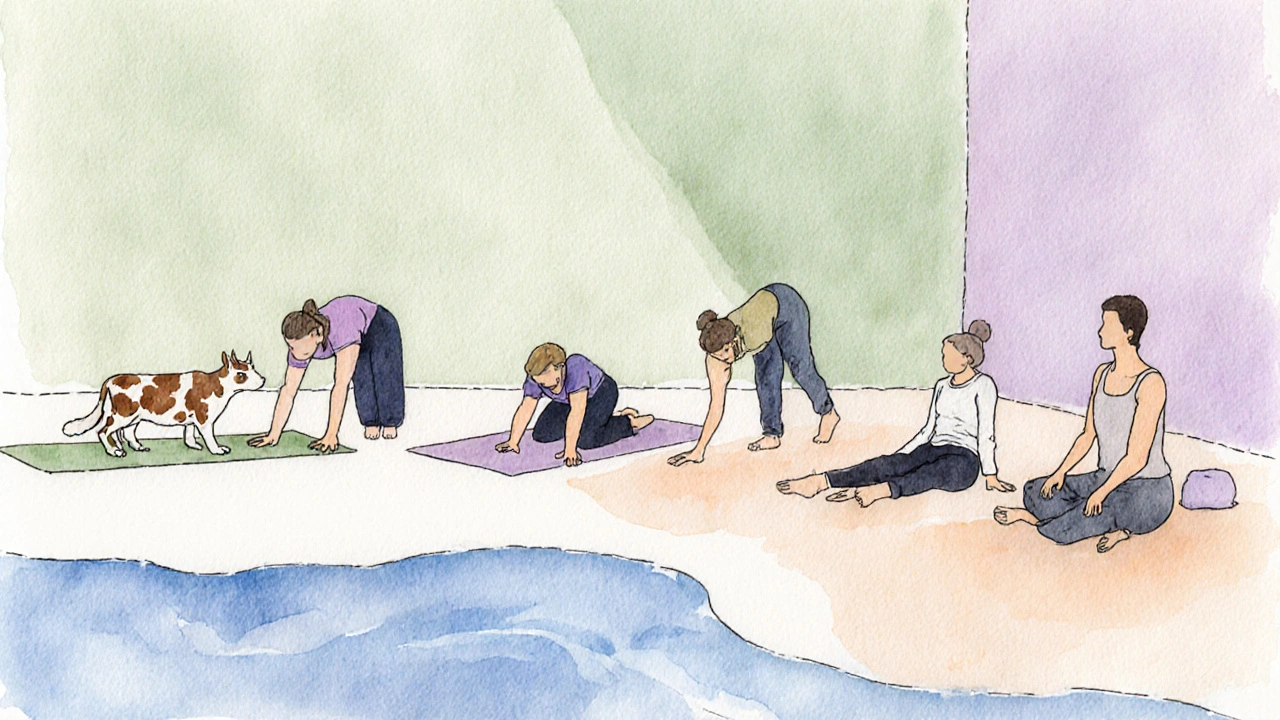
Gas Relief Yoga Timer
Yoga Routine Timer
Follow this 15-minute guided yoga routine to relieve gas and bloating. Each pose has a recommended hold time. The timer will guide you through the sequence.
Current Pose
Ready to begin your routine
Click Start to begin
Wind-Relieving Pose
Lie on back, hug knee to chest, press chin toward chest. Target: Lower abdomen, colon.
Hold: 30-60 seconds
Cat-Cow Sequence
On hands-knees, inhale arching back (Cow), exhale rounding spine (Cat). Sync breath with motion.
Rounds: 5-10
Seated Forward Bend
Sit tall, extend legs, hinge from hips, reach toward feet while keeping a long spine.
Hold: 1-2 minutes
Supine Twist
Lie on back, arms out, drop knees to one side, turn head opposite.
Hold: 45-60 seconds each side
If your stomach feels like a balloon that won’t stop inflating, you’re probably dealing with Meteorism is a condition characterized by excessive gas and bloating in the gastrointestinal tract. While a fleeting bout can be embarrassing, chronic meteorism often signals an imbalance in digestion, diet, or stress. The good news? A short, focused yoga practice can move trapped air, calm the nervous system, and restore smoother digestion. Below is a no‑fluff guide to the exact poses, breath work, and routine timing that target gas and bloating.
Quick Take
- Focus on forward bends, twists, and gentle inversions to compress and release abdominal pressure.
- Combine each pose with diaphragmatic breathing for maximum effect.
- A 15‑minute sequence performed twice daily can noticeably reduce bloating within a week.
- Consistency beats intensity - make the routine a habit, not a marathon.
- If pain persists, consult a healthcare professional.
Understanding Meteorism
At its core, meteorism is caused by gas buildup in the intestines. Common culprits include high‑fiber meals, carbonated drinks, and swallowed air (“aerophagia”). The gut microbiome plays a starring role: certain bacteria ferment carbohydrates and release hydrogen, methane, or carbon dioxide. When these gases accumulate faster than they can be expelled, you feel distended, tight, and sometimes uncomfortable.
Key physiological factors:
- Intra‑abdominal pressure - excess pressure can slow peristalsis.
- Diaphragmatic breathing - shallow chest breathing limits the diaphragm’s ability to massage abdominal organs.
- Gut motility - irregular movement of the digestive tract traps gas.
Yoga attacks these three points simultaneously: compression, twist, and breath.
Why Yoga Works for Digestion
When you flow through specific postures, you create a gentle massage for the intestines. Twisting poses rotate the mesentery, encouraging the passage of trapped air. Forward bends compress the belly, pushing gas toward the lower colon where it can be released. Inverting the torso even slightly (as in legs‑up‑the‑wall) reverses the pressure gradient, letting the diaphragm move more freely. Pairing each movement with Pranayama deepens the effect by activating the parasympathetic nervous system, which relaxes the sphincters and speeds up peristalsis.
Core Poses for Gas Relief
Below are the seven most effective asanas. Each description includes entry cues, duration, and a tip for maximizing gas release.
| Pose | Target Area | How to Perform | Suggested Hold |
|---|---|---|---|
| Wind‑Relieving Pose (Pavanamuktasana) | Lower abdomen, colon | Lie on back, hug right knee to chest, hold left leg straight. Press the chin toward the chest. | 30‑60seconds each side |
| Cat‑Cow Sequence (Marjaryasana‑Bitilasana) | Spinal flexion/extension, diaphragmatic movement | On hands‑knees, inhale arching back (Cow), exhale rounding spine (Cat). Sync breath with motion. | 5‑10 rounds |
| Seated Forward Bend (Paschimottanasana) | Entire abdomen, liver, pancreas | Sit tall, extend legs, hinge from hips, reach toward feet while keeping a long spine. | 1‑2minutes |
| Supine Twist (SuptaMatsyendrasana) | Oblique muscles, intestinal tract | Lie on back, arms out, drop knees to one side, turn head opposite. | 45‑60seconds each side |
| Child’s Pose (Balasana) | Lower back, pelvic floor | Kneel, sit on heels, stretch arms forward, forehead to mat. | 2‑3minutes |
| Legs‑Up‑the‑Wall (ViparitaKarani) | Venous return, diaphragm relaxation | Sit sideways against wall, swing legs upward, let back rest on floor. | 3‑5minutes |
| Deep Belly Breathing | Diaphragm, intra‑abdominal pressure | Inhale through nose expanding belly, exhale slowly through pursed lips. | 5‑10 breaths per pose |

Step‑by‑Step 15‑Minute Routine
- Start with Cat‑Cow - 5 rounds. Move slowly, feeling the belly rise and fall.
- Transition to Wind‑Relieving Pose. Hold each side for 45 seconds, breathing into the belly.
- Slide into Seated Forward Bend. Keep a soft bend in the knees if hamstrings are tight.
- Come onto your back for Supine Twist. Switch sides after the hold.
- Rest in Child’s Pose for 2 minutes, letting the breath settle.
- Finish with Legs‑Up‑the‑Wall while practicing deep belly breathing.
- Inhale for a count of four, exhale for six, repeating 8‑10 times.
Do this sequence once in the morning and once after dinner. Consistency helps the gut microbiome settle into a rhythm that produces less gas.
Tips & Common Mistakes
- Don’t force a deep forward bend. Over‑stretching can increase abdominal pressure, trapping more air.
- Keep the neck neutral during twists; turning the head too far can create tension in the throat muscles, making you swallow more air.
- Pair each pose with diaphragmatic breathing - chest‑only breaths negate the massage effect.
- Avoid tight clothing that compresses the belly; it interferes with the natural flow of gas.
- If a pose feels painful, modify with a bolster or pillow.
When to Seek Professional Help
Yoga is a fantastic first‑line tool, but watch for red flags that merit a doctor’s review:
- Severe, sudden abdominal pain or swelling.
- Unexplained weight loss or chronic diarrhea.
- Persistent bloating that doesn’t improve after two weeks of consistent practice.
- History of gastrointestinal disease (IBS, Crohn’s, ulcerative colitis).
A healthcare provider can rule out underlying conditions such as small‑intestinal bacterial overgrowth (SIBO) or food intolerances that require dietary changes or medication.
Putting It All Together: A Sample Weekly Planner
| Day | Morning | Evening |
|---|---|---|
| Monday | 15‑min routine | 15‑min routine |
| Tuesday | 15‑min routine | Gentle walk+breathing |
| Wednesday | 15‑min routine | 15‑min routine |
| Thursday | Restorative yoga (20min) | 15‑min routine |
| Friday | 15‑min routine | 15‑min routine |
| Saturday | Outdoor yoga flow (30min) | Legs‑Up‑the‑Wall only |
| Sunday | Mindful breathing (10min) | 15‑min routine |
Adjust the plan based on your schedule, but aim for at least 10 minutes of focused practice each day.
Final Thought
While Yoga for gas relief isn’t a miracle cure, the combination of targeted asanas, mindful breath, and regularity creates a powerful natural antidote to meteorism. Give your gut the gentle massage it craves, and you’ll likely notice less bloating, smoother digestion, and a calmer belly.

Frequently Asked Questions
Can I do these poses if I have back pain?
Yes, most poses are low‑impact. Keep your spine neutral, use blankets for support, and avoid deep forward bends that aggravate the lower back. If pain spikes, stop and consult a physiotherapist.
How soon will I feel less bloated?
Many people notice relief after a few sessions, especially when they pair yoga with reduced carbonated drinks. Consistent practice for 7‑10 days usually yields noticeable reduction.
Should I eat before doing the routine?
It’s best to practice on an empty stomach or at least 2‑3hours after a meal. Light snacks like a banana are fine, but heavy or greasy foods can worsen bloating during the session.
What breathing technique works best?
Diaphragmatic (belly) breathing - inhale through the nose, feeling the belly expand, then exhale slowly through pursed lips. This activates the parasympathetic nervous system and helps push gas toward the exit.
Can I combine this with probiotic supplements?
Absolutely. Probiotics can rebalance the gut microbiome, reducing gas‑producing bacteria. Take a high‑quality probiotic with a meal, and use the yoga routine to help move the food through the system.

17 Comments
Thanks for the detailed guide. I’ve tried the cat‑cow and wind‑relieving poses and felt a bit less bloated. The timer feature is a nice touch, especially when I’m in a rush. Keep the updates coming!
It is truly astonishing how one might locate a succinct 15‑minute regimen amidst the labyrinthine discourse of modern wellness. One can only marvel at the sheer ingenuity of compressing such a comprehensive protocol into a palatable duration. Evidently, the author has achieved a feat worthy of commendation, albeit with a sprinkle of inevitable redundancy.
In the grand theater of bodily unrest, gas becomes the silent antagonist, whispering chaos into our core. The presented sequence acts as a humble conductor, coaxing order from the tempest of intestinal discord. Yet, one must contemplate whether reliance on external postures merely masks deeper dietary transgressions that foment such unrest.
lol u r right, but i think if u ate less beans u wont need all that yoga lol
Oh, dear reader, I feel the weight of that ballooned belly you described; it is as if every sigh carries the echo of discomfort. The gentle flow you have curated offers a lifeline, a soothing balm to the churning storm within. May each breath be a whisper of relief, and every pose a step toward serenity.
One cannot help but wonder if the pharmaceutical giants are quietly averting attention from such natural remedies, preferring to peddle pills that mask the problem instead of addressing the root cause.
Great rundown! If you’re just starting, try holding the seated forward bend with a pillow under your knees to keep it gentle. Pair each pose with three deep belly breaths and you’ll notice the bloating easing in no time.
You’ll feel the difference quickly.
I’ve been watching my digestion for years, and honestly, the way you break down each pose feels like a conversation with a wise old friend who knows exactly how my gut ticks. There’s something comforting about the step‑by‑step format; it removes the intimidation factor that usually comes with yoga jargon and replaces it with a practical roadmap. The inclusion of a weekly planner is especially useful because it adds that structured rhythm my irregular schedule craves. Plus, the reminder to avoid tight clothing is a detail that many overlook, yet it makes a world of difference when you’re trying to let that trapped air escape. All in all, this guide hits the sweet spot between thoroughness and approachability, and I can see myself referring back to it whenever my stomach decides to throw a tantrum.
The guide’s emphasis on diaphragmatic breathing aligns with established gastroenterological recommendations, reinforcing its credibility.
When one examines the physiology of meteorism, the interplay between intra‑abdominal pressure and neural regulation emerges as a delicate symphony.
Yoga, in this context, functions not merely as a series of stretches but as a calibrated mechanical massage of the viscera.
Each forward bend compresses the gastrointestinal tract, encouraging the migration of gas toward the pyloric sphincter.
Twisting postures, meanwhile, create a torsional force that mobilizes the mesentery, facilitating the redistribution of gaseous pockets.
The supine twist, for instance, offers a gentle rotation that can dislodge trapped bubbles without invoking excessive muscular strain.
Conversely, the cat‑cow sequence modulates the diaphragm’s excursion, enhancing the thoraco‑abdominal pump that naturally expels excess air.
It is noteworthy that the respiratory rhythm synchronized with movement amplifies parasympathetic activation, a state conducive to peristalsis.
From a biomechanical standpoint, the legs‑up‑the‑wall pose inverses the gravitational vector, allowing venous return to improve and the diaphragm to relax.
Such inversion, albeit mild, can reduce the sensation of bloating by alleviating pressure on the lower abdomen.
Moreover, the prescribed duration of each pose respects the viscoelastic properties of connective tissue, preventing overstretch while still delivering therapeutic benefit.
Consistency, as highlighted in the weekly planner, leverages the principle of neuroplasticity, whereby the nervous system adapts to regular stimulus with increased efficiency.
In practical terms, a twice‑daily fifteen‑minute session integrates seamlessly into most adult routines without imposing undue burden.
Nevertheless, practitioners should remain vigilant for red‑flag symptoms that may indicate pathology beyond functional gas retention.
Should pain, unexplained weight loss, or persistent diarrhea arise, an immediate medical consultation is warranted.
In sum, the amalgamation of targeted asanas, mindful breath, and disciplined scheduling constitutes a robust, low‑cost strategy for mitigating meteorism.
I appreciate the depth of the anatomical explanation; it gives the routine a scientific backbone that many casual yoga posts lack. That said, not everyone has the luxury of a quiet space for a full 15‑minute session, so offering micro‑break alternatives could broaden accessibility. Still, the stepwise clarity is commendable and should help users stick with the plan.
This is a solid, easy‑to‑follow guide that anyone can jump into. Just remember to keep your back straight during the twists – slouching does n0t help. If you feel any sharp pain, stop immediatly and look into a doc. Also, drink water before you start; it helps move things along.
While the post is undeniably thorough, one might argue that the reliance on yoga overlooks more sophisticated medical interventions-yet, who am I to dismiss a centuries‑old practice? 🤔✨
We should focus on strengthening our own bodies instead of importing foreign wellness trends.
Totally agree! Let’s keep it real and stick to what works for us :)
The information is accurate and well presented.